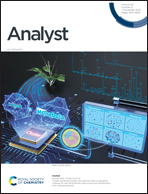A deep clustering-based mass spectral data visualization strategy for anti-renal fibrotic lead compound identification from natural products†
Abstract
Natural products have been a key source of drug lead discovery. However, their identification has long been a challenge even with the state-of-the-art analysis technologies like high-resolution mass spectrometry (MS) due to their complexity. Emerging in silico chemical structure prediction tools have provided time-saving and highly efficient approaches for identification of these complex samples. Nevertheless, the interpretation of these MS annotations into key supporting evidence towards specific questions is still a bottleneck in medicinal and biological fields. Here we present a deep clustering-based MS data visualization strategy (MCnebula), integrated with the influential open-source automatic MS annotation platform SIRIUS and in vivo and in vitro methods, to screen and validate potential lead compounds from natural products. MCnebula could provide multi-layer clustering profiles with chemical ontologies and comparative analysis of differential treatments. Plantaginis Semen (PS) is commonly used for treating kidney disease and usually stir-fried with salt water to enhance its anti-renal fibrosis effect, but the reason behind this remains unclear. Taking PS as an example, we comprehensively identified and compared the raw and processed PS extracts with SIRIUS-MCnebula, and screened potential anti-renal fibrotic lead compounds using weighted fold change analysis. Eighty-nine components were identified in PS with isoacteoside, calceolarioside B, 2′-acetylacteoside, and plantainoside D being screened and validated to treat renal fibrosis. The novel developed mass spectral data visualization strategy combined with biological function investigation and validation workflow could not only accelerate the discovery of lead compounds from medicinal natural products, but also shed new light on the traditional processing theory.

- This article is part of the themed collection: Analyst HOT Articles 2022


 Please wait while we load your content...
Please wait while we load your content...